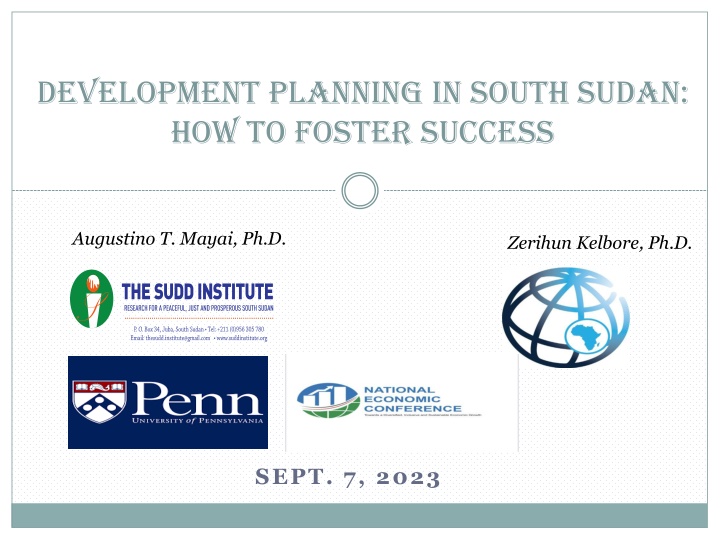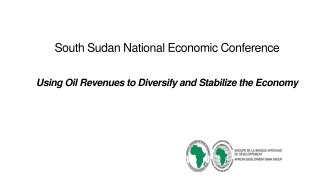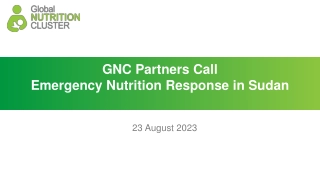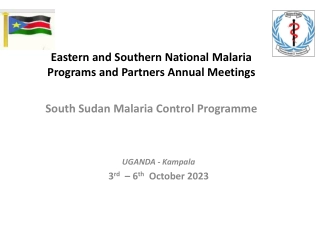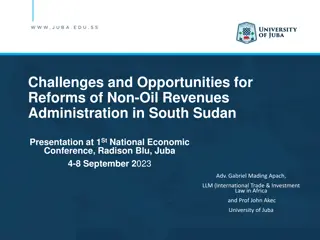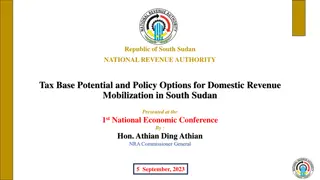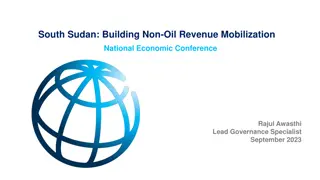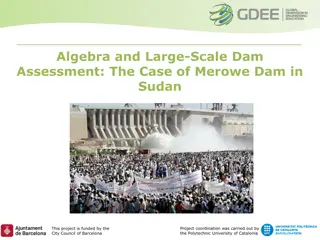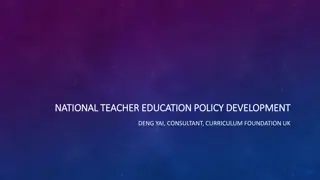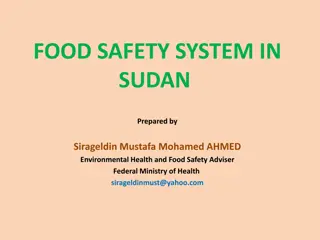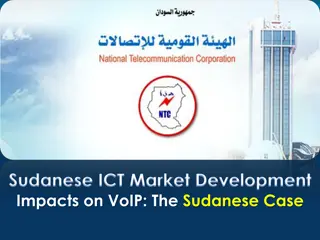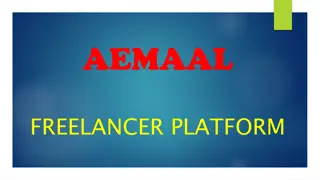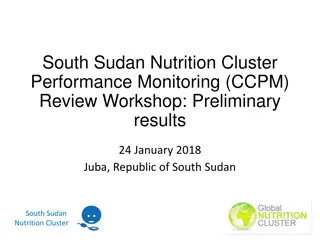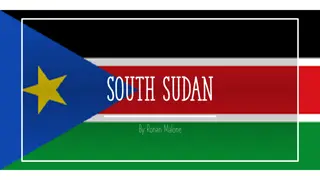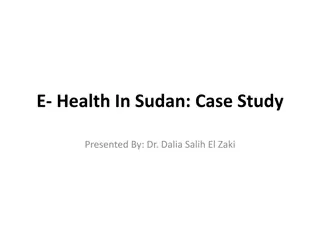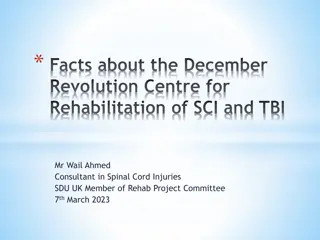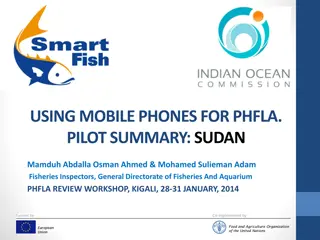Development Planning in South Sudan: Enhancing Success through Strategic Reforms
South Sudan faces severe developmental challenges with inefficient planning processes leading to colossal inefficiencies and wastage of resources. This article delves into the existing issues in development planning in South Sudan and presents insights on fostering success through impactful reforms and strategic initiatives.
Download Presentation

Please find below an Image/Link to download the presentation.
The content on the website is provided AS IS for your information and personal use only. It may not be sold, licensed, or shared on other websites without obtaining consent from the author.If you encounter any issues during the download, it is possible that the publisher has removed the file from their server.
You are allowed to download the files provided on this website for personal or commercial use, subject to the condition that they are used lawfully. All files are the property of their respective owners.
The content on the website is provided AS IS for your information and personal use only. It may not be sold, licensed, or shared on other websites without obtaining consent from the author.
E N D
Presentation Transcript
Development Planning in South Sudan: How to Foster Success Augustino T. Mayai, Ph.D. Zerihun Kelbore, Ph.D. SEPT. 7, 2023
Framing the Issues South Sudan has the lowest of development indicators in the world, marked by high rates of maternal and child death, run-away inflation, literacy rates below one-third of the population, 5.3% has access to electricity, and less than 2% of paved road networks (World Bank 2011, World Bank 2022). Yet there is little national development planning that occurs. What currently occurs is hardly PLANNED, and FRAGMENTED. E.g., nearly all South Sudan s government conceived development projects do not often emanate from empirical analyses of issues, informing design features and resource envelope. At times, contractors determine what is needed, what they deliver, and the cost of the deliverables. So why care? Colossal Inefficiencies wasting limited resources, a direct assault on the economy. E.g., Bahr el Ghazal Road. The exemplars of this picture are in order.
Paying for what matters: government spending Source: MoFP sdata; author s estimates.
Paying for what matters: security sector spending Figure 2. Conflict and security sector spending, 2006-2018 140 60 120 50 100 40 Number of conflicts Spending (%) 80 30 60 20 40 10 20 0 0 2004 2006 2008 2010 2012 Year 2014 2016 2018 2020 Conflict events Security spending Source: Mayai, 2020.
Paying for what matters: security sector spending Figure 3. Security sector vs. development sectors spending, 2006-2018 60 50 40 Spending (%) 30 20 10 0 2004 2006 2008 2010 2012 2014 2016 2018 2020 Security sector Development programs Source: Mayai, 2020.
Project Exemplars 100 days 30 Schools Project (i.e., speaking at the first sitting of Parliament in an independent South Sudan on August 10, 2011, President Kiir pledged to ensure that 30 new primary and four secondary schools are constructed within the first 100 days of his new government in office. ) Dura Project (i.e., in May 2013, the government of South Sudan launched a criminal investigation into the "dura saga," in which the government paid the equivalent of nearly $290 million for cereals that were never delivered). 1000 Tractors (these were distributed across the 10 states; this project failed). Letter of Credit(i.e., in 2021, South Sudan s Auditor General revealed that the letters of credit (LC) issued by South Sudan s government to various institutions to import commodities and try to stabilize prices were diverted to personal pockets).
Project exemPlars contd Fuel Subsidy, 2016-2018 The government adopted a fuel subsidy policy in January 2016 following the SSP floating. Meant to shield the citizens from inflation and to stabilize the energy and related sectors market, this policy committed the government to cover a 40% share of the fuel cost, a contribution of $180M annually. Typically, the subsidy was to keep the prices of energy dependent commodities, imports, and services, such as water, medical and educational supplies, food, electricity, and transport, relatively low. And as fuel became increasingly scarce, water tankers and public transport vehicles received a preferential treatment, obtaining weekly allocations at pump prices. Source: Mayai & Adam, 2022 (Working Paper).
Policy implication The point an analysis of these experiences makes is that investments compelled by political impulses hardly deliver desirable results. For a country with very limited resources and high expectations from the citizens, this trajectory is undoubtedly unsustainable.
Possible policy solutions To address this gap, a new institution, fully tasked with national planning and development, a public technical agency, is proposed. This institution, the National Development Planning Authority/Agency (NDA), would advance a renewed social contract between the South Sudanese Citizenry and their State by restoring investment programs in the people through development. Its principal objective would be to guarantee sufficient endowments in developmental activities, in turn adequately responding to people s expectations and aspirations. Put yet another way, the proposed development authority/agency would be largely tasked with identifying and assessing national development priorities (including cost), designing and supervising approved projects (in collaboration with specialized agencies), and certifying completed projects.
Possible policy solutions Specific roles of the proposed institution include: Lead the formulation and coordination of national development planning Coordinate the efforts of MDAs and states towards the pillars in the Development Planning Coordinates and oversees the generation of national statistics on all of development programs. Guides the agenda on public investment management towards strategic directions which help achieve the proposed development objectives and transformation in the development plan Routinely conducts development-centered research to inform new and ongoing development activities/priorities. Based on an integrated national system, monitors and evaluates resource allocations and milestones attained providing evidence on the value for money.
